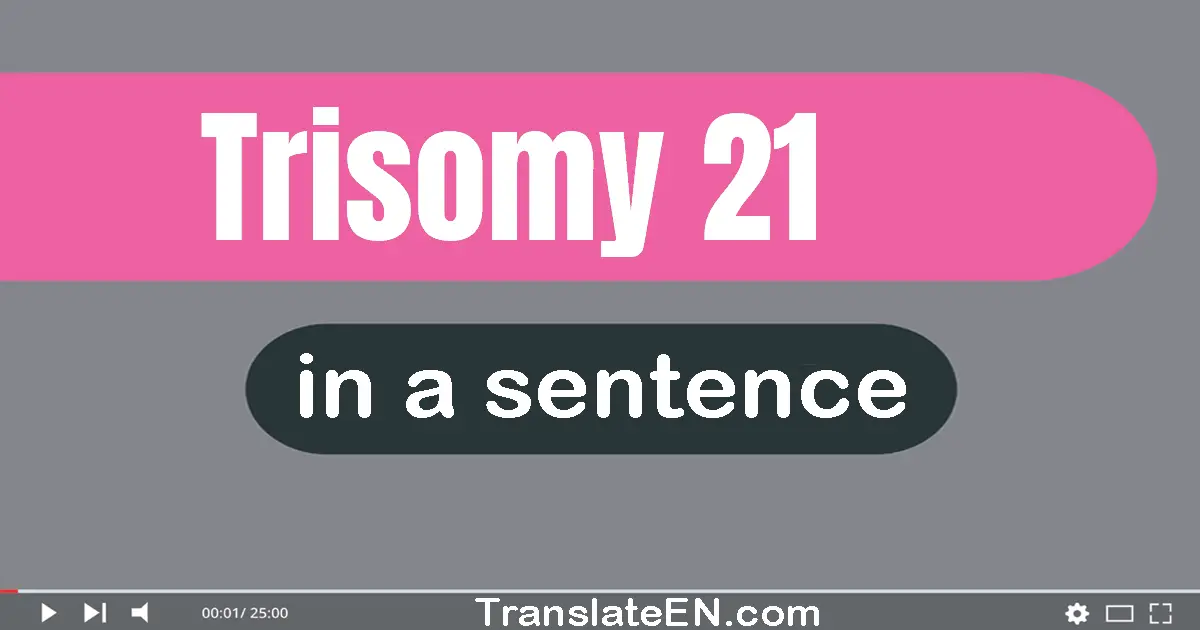Trisomy 21 in a sentence

(1) Trisomy 21 is the medical term for Down syndrome.
(2) People with trisomy 21 often have a shorter stature.
(3) People with trisomy 21 may have intellectual disabilities.
(4) Trisomy 21 is typically diagnosed through genetic testing.
(5) Trisomy 21 is named after the third copy of chromosome 21.
(6) Trisomy 21 can affect both physical and cognitive abilities.
(7) Trisomy 21 is not inherited, but rather occurs spontaneously.
(8) Trisomy 21 occurs when there is an extra copy of chromosome 21.
(9) Prenatal screening tests can detect the presence of trisomy 21.
(10) Individuals with trisomy 21 often have distinct facial features.
Trisomy 21 sentence
(11) Trisomy 21 is the most common chromosomal abnormality in humans.
(12) Trisomy 21 can lead to various health issues, such as heart defects.
(13) Individuals with trisomy 21 can lead fulfilling and meaningful lives.
(14) People with trisomy 21 may have a higher susceptibility to infections.
(15) Trisomy 21 is a lifelong condition that requires ongoing medical care.
(16) The risk of having a child with trisomy 21 increases with maternal age.
(17) Children with trisomy 21 may experience delayed development milestones.
(18) Trisomy 21 is caused by an error in cell division during fertilization.
(19) Trisomy 21, also known as Down syndrome, is the most common form of trisomy.
(20) People with trisomy 21 may have a higher risk of developing thyroid problems.
Trisomy 21 make sentence
(21) Trisomy 21 is associated with an increased risk of certain medical conditions.
(22) Trisomy 21 is caused by a random error in cell division during early development.
(23) Trisomy 21 is associated with an increased risk of developing Alzheimer's disease.
(24) Trisomy 21 is caused by an extra chromosome, resulting in a total of 47 chromosomes.
(25) Trisomy 21 is characterized by certain physical features, such as almond-shaped eyes.
(26) Individuals with trisomy 21 may have difficulty with speech and language development.
(27) Early intervention programs can help individuals with trisomy 21 reach their full potential.
(28) Trisomy 21 is not curable, but various therapies and treatments can improve quality of life.
(29) People with trisomy 21 may have a higher likelihood of developing certain types of leukemia.
(30) The life expectancy of individuals with trisomy 21 has significantly increased over the years.
(31) The term mongolism has been replaced with more accurate and respectful terms such as Down syndrome or trisomy 21.
(32) Individuals with trisomy 21 may benefit from early intervention therapies, such as physical and occupational therapy.
Trisomy 21 meaning
Trisomy 21, also known as Down syndrome, is a genetic disorder caused by the presence of an extra copy of chromosome 2
1. Individuals with trisomy 21 often have distinct physical features, intellectual disabilities, and may experience various health issues. When using the term "trisomy 21" in a sentence, it is important to provide accurate information and use appropriate language. Here are some tips on how to incorporate this term effectively:
1. Define the term: Begin by providing a brief definition or explanation of trisomy 2
1.
For example, "Trisomy 21, commonly known as Down syndrome, is a genetic condition characterized by the presence of an extra copy of chromosome 21."
2. Be sensitive and respectful: When discussing trisomy 21, it is crucial to use respectful and person-first language. Instead of saying "a trisomy 21 child," opt for "a child with trisomy 21" or "an individual with Down syndrome." This emphasizes the personhood of individuals with the condition.
3. Provide context: When using the term, it is helpful to provide some context or background information. For instance, "Trisomy 21 affects approximately 1 in 700 births worldwide" or "Individuals with trisomy 21 often exhibit certain physical characteristics, such as almond-shaped eyes and a flat facial profile."
4. Discuss associated health issues: Trisomy 21 can lead to various health concerns, such as heart defects, hearing loss, and thyroid problems. When using the term, consider mentioning some of these associated health issues.
For example, "Children with trisomy 21 may require regular cardiac evaluations due to an increased risk of congenital heart defects."
5. Highlight strengths and abilities: While trisomy 21 is associated with certain challenges, it is essential to recognize the strengths and abilities of individuals with the condition. When using the term, consider mentioning their unique talents and capabilities. For instance, "Many individuals with trisomy 21 possess a remarkable ability to bring joy and happiness to those around them."
6. Discuss inclusion and support: Trisomy 21 is a condition that requires support and inclusion within society. When using the term, it is beneficial to discuss the importance of creating inclusive environments and providing necessary support for individuals with trisomy 2
1.
For example, "Inclusive education and employment opportunities play a vital role in empowering individuals with trisomy 21 to reach their full potential."
7. Provide resources: If appropriate, include information about resources, organizations, or support groups that can provide further information or assistance related to trisomy 2
1. This can help readers or listeners access additional support or gain a deeper understanding of the condition. Remember, when using the term "trisomy 21" in a sentence, it is crucial to be respectful, accurate, and sensitive to the experiences of individuals with the condition. By following these tips, you can effectively incorporate this term into your writing or conversation while promoting understanding and inclusivity.
The word usage examples above have been gathered from various sources to reflect current and historical usage of the word Trisomy 21. They do not represent the opinions of TranslateEN.com.
